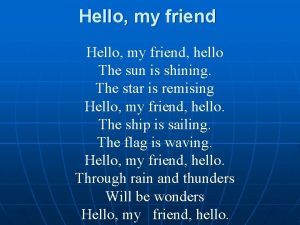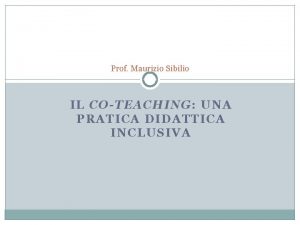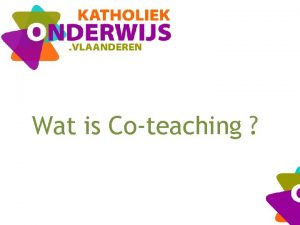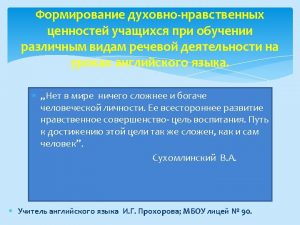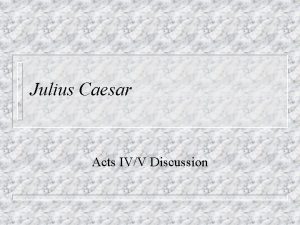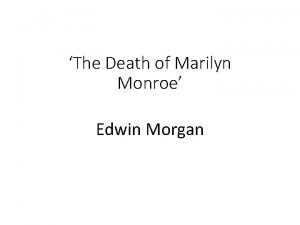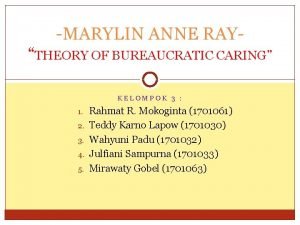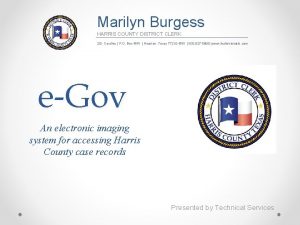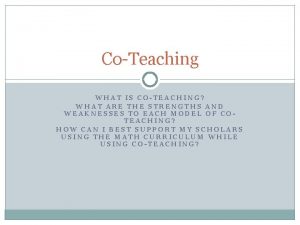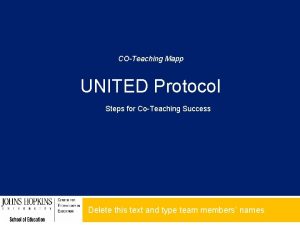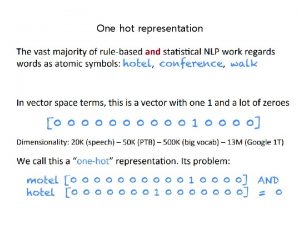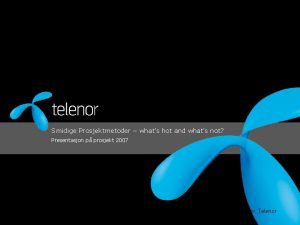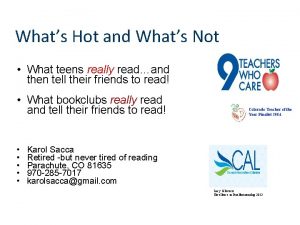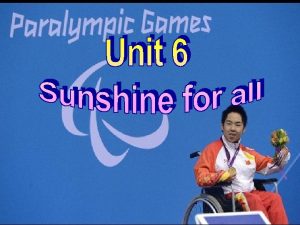CoTeaching Whats Hot Whats Not Marilyn Friend Ph




























- Slides: 28

Co-Teaching: What’s Hot, What’s Not! Marilyn Friend, Ph. D. marilynfriend@marilynfriend. com IL CEC Conference November 4, 2016

Topics for the Session 1. Instruction as the focus in co-taught classes 2. Co-teaching and the contemporary State education standards 3. Expectations for students with disabilities in co -taught classes 4. Teacher roles and reciprocity 5. Electronic collaboration

INSTRUCTION AS THE FOCUS IN CO-TAUGHT CLASSES

Co-Teaching is… __________

Specially Designed Instruction

HOT! SDI Characteristics • Tailored to assessed student PLOP and addresses disability/IEP goals • Changes in content, methodology, or delivery of instruction (e. g. , direct/explicit) • Systematic, carefully planned, monitored • Goal is curriculum access • Requires SET skills

NOT! • Co-teaching as a strategy for “push-in” for students with disabilities • Co-teaching as an option based on school and teacher preferences • Co-teaching as a nebulous way to provide “help” to students with disabilities • Quandary of meeting IEP goals written independently of grade-level curriculum

CO-TEACHING AND CONTEMPORARY STATE EDUCATION STANDARDS

HOT! Contemporary Co-Teaching How do we make sure we’re implementing State standards as part of our co-teaching?

Examples of Curricular Emphasis • Emphasis on informational text • Complex text • Argumentation/ point of view • Evidence to support responses • Inquiry-based instruction • Increased student engagement • Multiple approaches

NOT! • Instruction that is isolated rather than integrated (note IEP implications) • Instructional strategies that are teacher favorites but without an evidence base • Instruction with low engagement (e. g. , lengthy whole-group lecture) • Instruction that ignores principles of Universal Design for Learning

EXPECTATIONS FOR STUDENTS WITH DISABILITIES IN CO-TAUGHT CLASSES

Quiz: Out of Each 10 School-Age Students with Disabilities, How Many Have… • Learning disabilities? • Blind or low vision? • Emotional disabilities? • Deaf or hard-of-hearing? • Speech-only needs? • Autism? • Other health impairments? • Who’s left? (SW: ID, MD, DB, DD) • Physical disabilities? • What’s the point?

HOT! Out of every 10 students with disabilities, more than 8 of them have NO intellectual disability! 02. 05. 14 Marilyn Friend, Inc. © 2014

NOT! • Grouping students with disabilities with students with academic and behavior challenges • “Protecting” students with disabilities from challenging courses and instruction • Inadvertently lowering expectations for SWD and other students

TEACHER ROLES AND RECIPROCITY

GET Responsibilities • Knowledge of and skill for delivering grade level curriculum • Classroom management, including discipline • Knowledge of typical student characteristics and needs • Pacing of instruction

SET Responsibilities • Knowledge of and skills to delivery specially designed instruction • Understanding of unique individual student needs • Completion of all special educationrelated paperwork and procedures • Mastery model of instruction

HOT! GET and SET Co-Teaching Roles Academic Content Expertise General Educators Learning Process Expertise Special Educators

A Word About Teacher Evaluation • Overall applicability of new teacher evaluation systems to special educators • Attention to teacher evaluation/observation in co -taught classes • Teacher evaluation in the context of roles and responsibilities • Resource: http: //www. cec. sped. org/~/media/Files/Policy/CEC%20 Professional%20 Policies%20 and%20 Positions/Position _on_Special_Education_Teacher_Evaluation_Backgrou nd. pdf

Do Paraprofessionals Co-Teach? • Valuable personnel who play key roles in GE classrooms • Paras. DO NOT co-teach; they provide support to students and teachers • Roles cannot be reciprocal because of their employment status • May work on behalf of a single student or as general class support • Roles include data collection, review/practice, application, some chores

NOT! • Directionality (i. e. , GETs give permission to SETs) • SETs implementing only what “fits” or “is acceptable to” the GET • Rigid roles (e. g. , SET works primarily with students who struggle and addresses discipline; GET delivers curriculum) • Your kids and my kids • Paraprofessionals interchangeable with SETs

ELECTRONIC COLLABORATION

A Contemporary Co-Teaching Planning Model 1. Periodic, intensive face-to-face macro planning 2. Ongoing electronic planning 3. On-the-spot fill-in planning strategies

HOT! Planning on Calendars • Lesson planning on existing calendar • Calendar shared annotated to address SDI • Example: Outlook • Example: Google Calendar

HOT! Electronic Teacher Plan Books • Co-planning in the cloud • Dedicated to lesson planning so directly suited to that purpose • Most options allow lesson sharing using simple steps • Free or low cost (e. g. , $1. 00/month) • Examples: Planbook. com

NOT! • Face-to-face as a primary planning model • E-mail in lieu of other electronic collaboration options • Text messaging as planning • “What are we doing today? ”

HOT! References and Resources Causton, J. , & Theoharis, G. (2013). Inclusive schooling: Are we there yet? School Administrator, 70(2), 19 -25. Friend, M. (2015/2016, December-January). Welcome to co-teach 2. 0. Educational Leadership, 73(4), 16 -22. Friend, M. (2014). Co-Teach! Creating and sustaining effective classroom partnerships in inclusive schools (2 nd edition). Greensboro, NC: Marilyn Friend, Inc. Friend, M. , & Bursuck, W. (2015). Including students with special needs: A practical guide for classroom teachers (7 th edition). Upper Saddle River, NJ: Pearson/Merrill. . Friend, M. , Burrello, L. , & Burrello, J. (2009). More power: Effective instruction in co-taught classes. Bloomington, IN: Forum on Education, Indiana University. Friend, M. , & Cook, L. (2017). Interactions: Collaboration skills for school professionals (8 th edition). Upper Saddle River, NJ: Pearson. Huberman, M. , Navo, M. , & Parrish, T. (2012). Effective practices in high performing districts serving students in special education. Journal of Special Education Leadership, 25(2), 59 -71. Murawski, W. W. (2012). 10 tips for using co-planning time more efficiently. Teaching Exceptional Children, 44(4), 8 -15. Schillinger, M. , & Wetzel, B. (2014). Common core and the special education student: Your guide to instructional shifts and implementing services and supports. Palm Beach Gardens, FL: LRP Publications. Solis, M. , Vaughn, S. , Swanson, E. , & Mc. Culley, L. (2012). Collaborative models of instruction: The empirical foundations of inclusion and co-teaching. Psychology in the Schools, 4), 498 -510. Walsh, J. M. (2012). Co-teaching as a school system strategy for continuous improvement. Preventing School Failure, 56(1), 29 -36.
 Hello my friend hello song
Hello my friend hello song Hello my friend!
Hello my friend! Co teaching cos'è
Co teaching cos'è Coteaching
Coteaching Whats hot whats not
Whats hot whats not Marilyn friend co teaching
Marilyn friend co teaching Let's be a good friends
Let's be a good friends Foaf friend of a friend
Foaf friend of a friend A friend in needs a friend indeed
A friend in needs a friend indeed I've found a friend oh such a friend
I've found a friend oh such a friend Thou hast described a hot friend cooling.
Thou hast described a hot friend cooling. Uncontrolled, lacking in restraint
Uncontrolled, lacking in restraint White hot vs red hot temperature
White hot vs red hot temperature Advantage of hot working
Advantage of hot working Perbedaan hot lava dan hot lava volcano
Perbedaan hot lava dan hot lava volcano Hot nor hot
Hot nor hot Be a friend not a bully
Be a friend not a bully Is bent double like old beggars under sacks a metaphor
Is bent double like old beggars under sacks a metaphor Marilyn monroe biography
Marilyn monroe biography Billy graham marilyn monroe
Billy graham marilyn monroe Teori marilyn anne ray
Teori marilyn anne ray Marilyn monroe foto in rou gedig
Marilyn monroe foto in rou gedig Gladys pearl baker
Gladys pearl baker Marilyn burgess
Marilyn burgess Marilyn monroe taille 44
Marilyn monroe taille 44 John lennon se burlo de dios
John lennon se burlo de dios Cell membrane bubble lab answers
Cell membrane bubble lab answers L
L Marilyn monroe billy graham
Marilyn monroe billy graham
